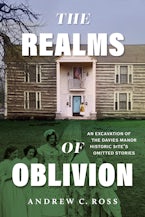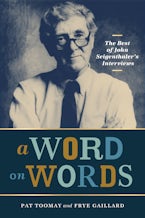- Home
- To Care for the Sick and Bury the Dead

To Care for the Sick and Bury the Dead
African American Lodges and Cemeteries in Tennessee
Benevolent Orders, the Sons of Ham, Prince Hall Freemasons—these and other African American lodges created a social safety net for members across Tennessee. During their heyday between 1865 and 1930, these groups provided members with numerous resources, such as sick benefits and assurance of a proper burial, opportunities for socialization and leadership, and the chance to work with local churches and schools to create better communities. Many of these groups gradually faded from existence, but their legacy endures in the form of the cemeteries the lodges left behind.
These Black cemeteries dot the Tennessee landscape, but few know their history or the societies of care they represent. To Care for the Sick and Bury the Dead is the first book-length look at these cemeteries and the lodges that fostered them.
This book is a must-have for genealogists, historians, and family members of the people buried in these cemeteries.
These Black cemeteries dot the Tennessee landscape, but few know their history or the societies of care they represent. To Care for the Sick and Bury the Dead is the first book-length look at these cemeteries and the lodges that fostered them.
This book is a must-have for genealogists, historians, and family members of the people buried in these cemeteries.
Preface
Introduction: A Time of Change: Tennessee between 1865 and 1930
Chapter 1: The Rise of Fraternalism
Chapter 2: Lodge Cemeteries in Tennessee
Chapter 3: The Importance of Fraternalism and Benevolence in the African American Community
Chapter 4: The Importance of Funerals and Cemeteries in Fraternalism
Chapter 5: Remembering the Dead: Commemoration in Lodge Cemeteries
Chapter 6: Segregated Landscapes
Chapter 7: The Silences of the Lodge Cemeteries: "Unmarked" Graves and Hiding in Plain Sight
Conclusion: The Persistence of Lodges and Lodge Cemeteries
Glossary of Terms
Notes
Bibliography
Index
Introduction: A Time of Change: Tennessee between 1865 and 1930
Chapter 1: The Rise of Fraternalism
Chapter 2: Lodge Cemeteries in Tennessee
Chapter 3: The Importance of Fraternalism and Benevolence in the African American Community
Chapter 4: The Importance of Funerals and Cemeteries in Fraternalism
Chapter 5: Remembering the Dead: Commemoration in Lodge Cemeteries
Chapter 6: Segregated Landscapes
Chapter 7: The Silences of the Lodge Cemeteries: "Unmarked" Graves and Hiding in Plain Sight
Conclusion: The Persistence of Lodges and Lodge Cemeteries
Glossary of Terms
Notes
Bibliography
Index
Leigh Ann Gardner is a grants manager at Vanderbilt University Medical Center. She also works in historic preservation.
A large “For Sale” sign, noting the site’s “great potential,” sits at the edge of a seemingly empty, large lot consisting of slightly over thirty-seven acres in southwest Memphis. Small trees and bushes located at the edge of the property along the road obscure the view, as does a short concrete fence. The real estate listing notes the great price for the parcel, offered for sale at $125,000, and notes its potential development uses: “residential, church, and park.” The listing has its present usage as “none/vacant” and notes that there are no improvements on the property. It is zoned for single family or commercial usage.
The lot is located on a four-lane road, with a state highway roughly a third of a mile away. To judge by the nearby church congregations, the neighborhood is likely predominantly African American. A CME church is three-tenths of a mile east of the lot, an African Methodist Episcopal (AME) Zion church lies three-tenths of a mile west, and one mile south is a Missionary Baptist Church. One of the churches has a small graveyard located on the property. Judging by the number of churches and homes in the area, this has obviously been a community for many years. The vacant lot is located a little over a mile south of Nonconnah Creek, and was likely part of the Nonconnah community. The interesting thing to note about the property, however, is not its development potential. This piece of property is also listed on the Shelby County Register of Deeds website as the site of the intriguingly named Union Forever Cemetery, established by the Union Forever Society. If the Register of Deeds site is correct, this is the site of an African American lodge cemetery, one of at least three in Shelby County. The Union Forever Society is one of hundreds of African American benevolent and fraternal groups that proliferated across the state beginning in the nineteenth century and were important parts of their communities.
If it is a cemetery, as it appears likely, there is little that can be done to protect those who may be interred here. Native American graves and burial remains are protected by the Native American Graves Protection and Repatriation Act (NAGPRA), enacted in 1990, which provides for the repatriation of items of cultural patrimony, including burial remains. Unmarked graves belonging to other ethnic or cultural groups, such as African Americans, can be excavated without a legal requirement to inform descendants or community stakeholders. In Tennessee, if developers find human remains on a property, they are required to stop work immediately and notify the local medical examiner, law enforcement, and state archaeologist. The state archaeologist will work with the developer to consider how the work can continue in such a way as to avoid the burials; in the event that is not possible, a legal process must be followed to move the graves to a different location. In Tennessee, state law allows for the termination of use as a cemetery of any burial ground that has been abandoned or is in neglected condition, or if it has activities or conditions nearby that do not display reverence for the dead. The most likely scenario for this site, if it is the Union Forever Cemetery, is that if the presence of human remains are detected during development, they will most likely be moved to a different location and reinterred. Although its future is uncertain, the condition of the Union Forever Cemetery is not necessarily indicative of the state of the other lodge cemeteries across the state. Each of the three Grand Divisions in Tennessee contain African American lodge cemeteries, and these cemeteries are important resources for learning more about African American lodges and their members, and how African American fraternal groups continue to endure as community institutions into the twenty-first century.
The lot is located on a four-lane road, with a state highway roughly a third of a mile away. To judge by the nearby church congregations, the neighborhood is likely predominantly African American. A CME church is three-tenths of a mile east of the lot, an African Methodist Episcopal (AME) Zion church lies three-tenths of a mile west, and one mile south is a Missionary Baptist Church. One of the churches has a small graveyard located on the property. Judging by the number of churches and homes in the area, this has obviously been a community for many years. The vacant lot is located a little over a mile south of Nonconnah Creek, and was likely part of the Nonconnah community. The interesting thing to note about the property, however, is not its development potential. This piece of property is also listed on the Shelby County Register of Deeds website as the site of the intriguingly named Union Forever Cemetery, established by the Union Forever Society. If the Register of Deeds site is correct, this is the site of an African American lodge cemetery, one of at least three in Shelby County. The Union Forever Society is one of hundreds of African American benevolent and fraternal groups that proliferated across the state beginning in the nineteenth century and were important parts of their communities.
If it is a cemetery, as it appears likely, there is little that can be done to protect those who may be interred here. Native American graves and burial remains are protected by the Native American Graves Protection and Repatriation Act (NAGPRA), enacted in 1990, which provides for the repatriation of items of cultural patrimony, including burial remains. Unmarked graves belonging to other ethnic or cultural groups, such as African Americans, can be excavated without a legal requirement to inform descendants or community stakeholders. In Tennessee, if developers find human remains on a property, they are required to stop work immediately and notify the local medical examiner, law enforcement, and state archaeologist. The state archaeologist will work with the developer to consider how the work can continue in such a way as to avoid the burials; in the event that is not possible, a legal process must be followed to move the graves to a different location. In Tennessee, state law allows for the termination of use as a cemetery of any burial ground that has been abandoned or is in neglected condition, or if it has activities or conditions nearby that do not display reverence for the dead. The most likely scenario for this site, if it is the Union Forever Cemetery, is that if the presence of human remains are detected during development, they will most likely be moved to a different location and reinterred. Although its future is uncertain, the condition of the Union Forever Cemetery is not necessarily indicative of the state of the other lodge cemeteries across the state. Each of the three Grand Divisions in Tennessee contain African American lodge cemeteries, and these cemeteries are important resources for learning more about African American lodges and their members, and how African American fraternal groups continue to endure as community institutions into the twenty-first century.











